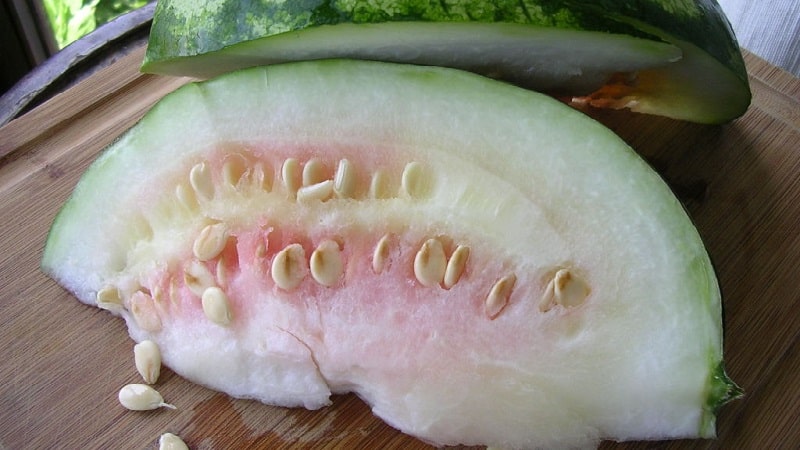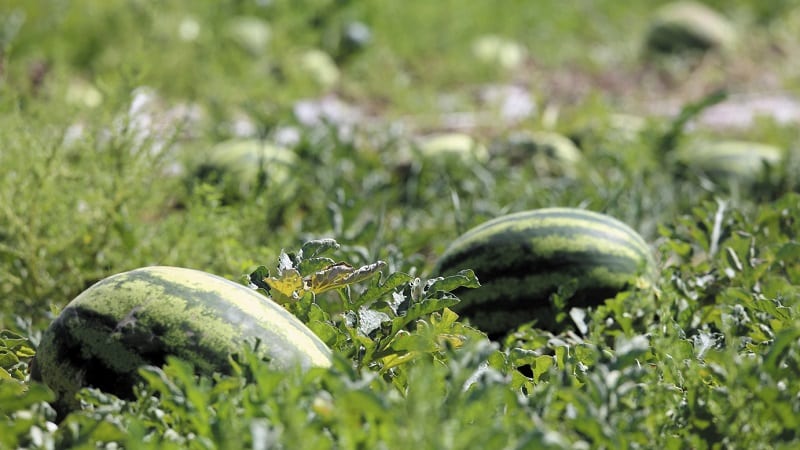What is a feed watermelon, who is fed it and how does it differ from a regular one?
Many common agricultural crops have “fodder” analogues, that is, varieties grown for animal food.
From the article you will learn what feed watermelons are and how they differ from ordinary ones.
What is feed watermelon
Fodder watermelon - this is a melon crop specially grown for further use as livestock feed. Contains a lot of moisture, vitamins, minerals, therefore it is primarily intended to increase the milk yield of dairy cattle. In our country, the most common fodder variety is Diskhim; it was bred in the 50s of the last century in the south of Russia.

Botanical description
Fodder watermelon is an annual herbaceous plant from the Pumpkin family., related to the common table watermelon - it is believed that they have one common ancestor. All species of this plant are native to South Africa.
Interesting facts about table watermelon:
Description and characteristics
Forage watermelon has a strong and branched root system, the central part is capable of rooting 5 m deep. The stem of the plant is a vine that spreads along the ground, its length is 3-5 m. The crop is wind-resistant: the lashes have many tendrils, and the leaves are strongly dissected.
At the feed watermelon green, hairy leaves. The flowers are yellow, female and male, the plant is cross-pollinated. The fruit is large, round or oval, weighing up to 10 kg.The crust is green, thick, with light green stripes and spots. The pulp is pale, yellowish or white, sometimes even with a greenish tint, and the seeds are quite large.
Such Watermelon is rich in vitamins and minerals, contains substances beneficial for the growth and health of farm animals. They are fed fresh fruits of this melon crop, as well as frozen and silage-processed ones.
Interesting! In some countries, sweets are industrially produced from the fruits of the forage watermelon - candied mango, kiwi, and pineapple in China.
How is it different from normal
Feed watermelons external parameters resemble canteens. The fruit has a spherical shape, characteristic green stripes with a pattern reminiscent of marble.

How to distinguish by appearance
Watermelon for livestock feed larger than the usual table food, it has a thicker crust. Such fruits can be distinguished by their pulp: in forage ones it is pale, yellowish or pink, or even white with a greenish tint.
Forage plant characterized by longer lashes and stems.
Difference in taste
Feed watermelons as opposed to table watermelons do not have a pronounced sweet taste. Their taste is fresh, watery, sweetness is expressed only by a slight aftertaste.
For which animals are feed watermelons used?
First of all, forage melons are intended for feeding dairy cows and goats, since they are considered an effective milk feed. They improve the vitamin composition of milk and increase the appetite of animals. Such fruits will appeal to pigs and farm birds - ducks, geese, chickens, turkeys.
Technology and features of their cultivation
Fodder watermelons are grown where there are enough sunny days. These are the regions of the North Caucasus, the Lower and Middle Volga region, and the Primorsky Territory. If this type of melon crop is planted in areas not affected by irrigation, up to 30 tons of crop can be harvested per hectare. Irrigated lands yield almost twice as much harvest - up to 50 tons per hectare.
Watermelons for food require less carethan their table counterparts, which is why they are one of the first to be planted among melon crops.
Sowing
Watermelon, intended for animal feed, grows best in floodplains and on virgin lands., that is, where the soil is fertile. The growth of this plant largely depends on the presence/absence of weeds in the field. Watermelon grows well in sandy soils, but does not tolerate salt marshes and lowlands with high soil acidity.

The best predecessors - grains and legumes. And after it, spring grain crops grow well. Watermelon plantations are susceptible to diseases of melon crops, in particular Fusarium wilt, so it is worth planting it again in the same place no earlier than after 5-6 years.
Attention! Before sowing watermelon, the soil is enriched with mineral and organic fertilizers; during the growth period and before flowering, fertilizing with nitrogen, potassium, and phosphorus fertilizers is also desirable.
For planting, seeds are selected from well-ripened fruits.. First, the seeds are laid out to warm up in the sun, then treated with fungicides.
Pre-treated seeds germinate, so that the sprout begins to peck, and then planted in the soil. In this case, they sprout 9-10 after planting.
The timing of planting seeds depends on the ripening period of the forage watermelon variety.. If it is an early-ripening variety, then the soil should be heated to 12°C, if it is mid-ripening, then to 14°C, and if it is late-ripening, then to 16°C. The seeds are planted to a depth of about 10 cm. Most often, fodder watermelon is planted in the first half of May (in the Caucasus) or in the second half (in the Volga region).
Read also:
How to understand that a watermelon has gone bad and what to do with it
Care
The yield of a forage crop largely depends on clearing the field of weeds and timely fertilizing. In the period before emergence, watermelon crops are loosened with hoes.
This crop requires a lot of water - this applies to both table and feed watermelon. Therefore, after planting the seeds, the plantings are watered at least once every two weeks.

Harvest and storage
This forage crop is harvested on the 50-60th day after pollination.. Fodder watermelons are harvested shortly before the first frost. If the stem of the fruit has dried out, the bark has become rough, and a clear pattern is visible on it - the watermelon is ripe and can be harvested.
To store the crop better, leave the stalk after picking the berries from the bush. The collected fruits are stored almost all winter in dry storage at low (3-4°C) temperatures, as well as in the fields, sheltered from the wind with a haystack.
Attention! The harvested watermelon crop is fed to livestock in the fall, after harvest, or placed in silos for processing.
Conclusion
Fodder watermelon is a melon crop grown exclusively for feeding livestock - cows, pigs, and poultry. The fruits of this plant are easy to distinguish from table watermelon even by their external characteristics: the fruit one is larger, it has a thick, rough rind, and white or yellowish flesh. The taste is almost bland, with only a slight hint of sweetness.
Fodder watermelon grows in warm regions where there are enough sunny days and abundant periodic watering is possible. This crop requires fertilized fertile soils, clearing the field of weeds, fertilizing before flowering and periodic loosening of the soil. The harvest is up to 50 tons per hectare; it can be stored almost all winter.